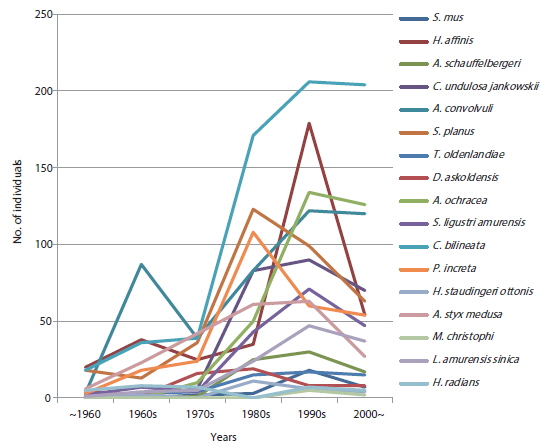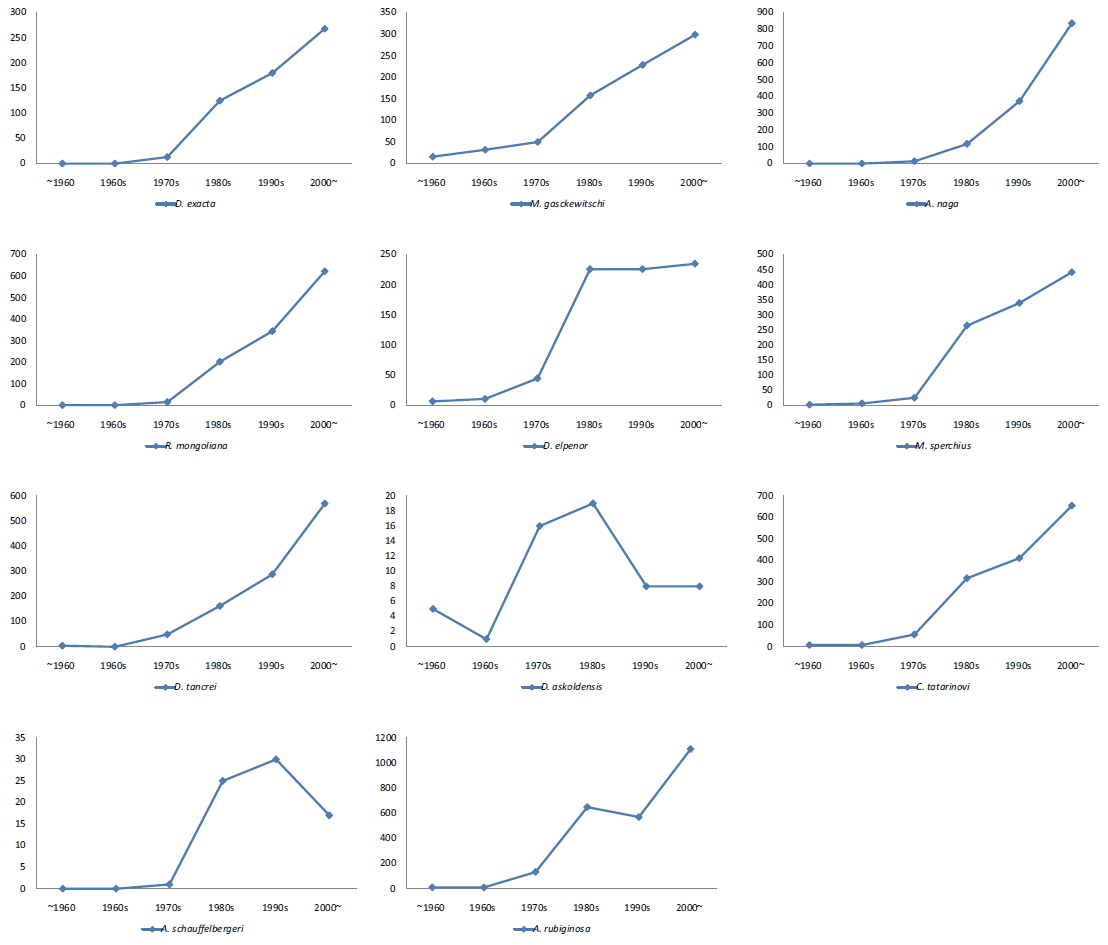



Countries all over the world are making efforts to secure their biological sovereignty and preserve their biological resources in various ways, such as by joining the Convention on Biological Diversity or adhering to the Nagoya protocol. In order to preserve the variety of organisms, it is very important to identify mutual relationships between biological factors and non-biological factors (environmental factors), as these can have considerable effects on the extinction or survival of a species.
Lepidoptera, including Sphingidae, is one of the largest taxonomic groups of insects. As it has high species abundance, it shows sensitive responses to changes in environments which are a non-biological factor, while also reflecting the environmental conditions of any given region. Additionally, Lepidoptera has a relatively short life cycle. Thus, many generations appear in a short time. It produces a large issue at one time and has relatively diverse habitats. Well-known taxonomic groups of Lepidoptera have been preferred indicators of various environmental changes (Erhardt 1985, Erhardt and Thomas 1991, Daily and Ehrlich 1995, Hill et al. 1995, Hill and Hamer 1998). Butterflies and moths that are active in the daytime out of Lepidoptera have been used as biological indicators. However, butterflies are not easy to catch and often appear only rarely in forest environments. On the other hand, many taxonomic groups of moths in Lepidoptera, which are active at night, are easy to collect by using light traps. As there are numerous species, they provide strong and diverse power of discrimination for detecting a range of effects on the ecology of a region (Holloway 1977, 1985). Additionally, moths in Sphingidae are larger than other moths and are therefore easy to observe. Furthermore, they are well known taxonomically (Holloway 1977, 1985) and have been used as models of living things in various diversity studies (León-Cortés et al. 1998). Therefore, moths in Sphingidae, which are active in the daytime and at night and for which a range of species exist, are considered to be a very good taxonomical group as biological indicators responding to environmental changes.
More than 1,000 species of moths in Sphingidae have been reported around the world (Carter 1992), and it has been reported that 33 Sphinginae species and 25 Macroglossinae species (58 species in total) have inhabited or presently inhabit in Korea (Paek et al. 2010). Maintaining a database of bio-organisms over time is the only way to secure bio-diversity and to identify distributions and life patterns in the past and present related to various environmental changes, such as weather changes. Thus, in this study, fluctuations in different species according to space and time are identified by collecting information on samples of Korean Sphingid moths housed in Korea to provide basic materials with which to identify causes of species abundance and to determine the distributions of various insects, including Sphingid moths, according to environmental changes.
>
Selection and collection of the research materials
To secure the basic materials used in this study, we contacted 15 national institutes, universities, and laboratories that were expected to have relatively abundant samples of Sphinginae moths. These institutions were selected out of domestic organizations which were known to house Sphingid moths. To obtain more accurate and reliable data, we have included at least one institute in each region. The number of selected institutions was 7 in Seoul and Gyeonggi-do, 1 in Gangwon-do, 3 in Chungcheongdo, 1 in Jeolla-do, 1 in Gyeongsang-do and 2 on Jeju Island (Table 1). We used sample information pertaining to a total of 53 species, or 21,414 individuals excluding samples that were less reliable in some way, such as missing or faulty information on the location grid or the year of the survey (Table 2).
[Table 1.] The list of institutions investigated in this study
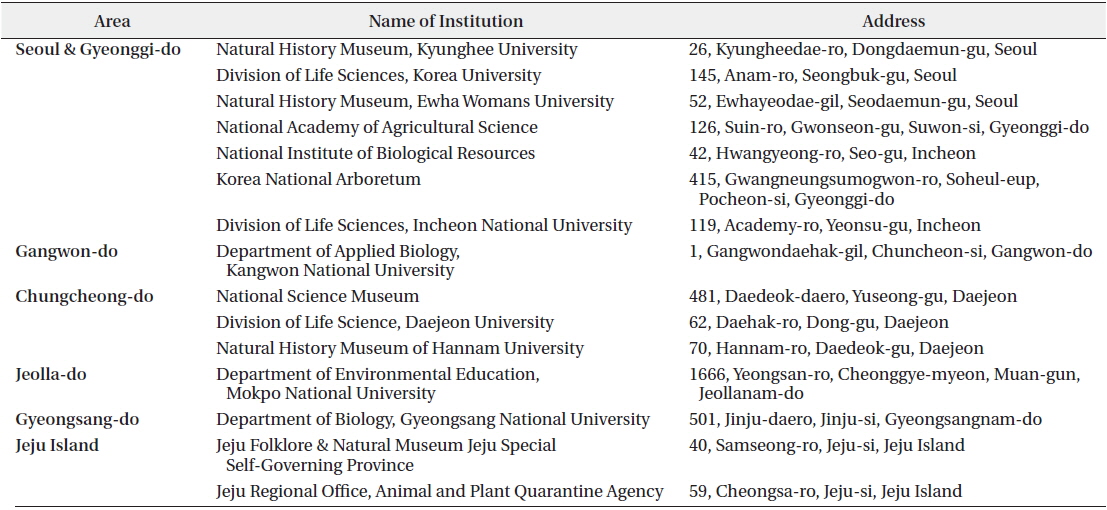
The list of institutions investigated in this study
[Table 2.] Number of data samples used in the study
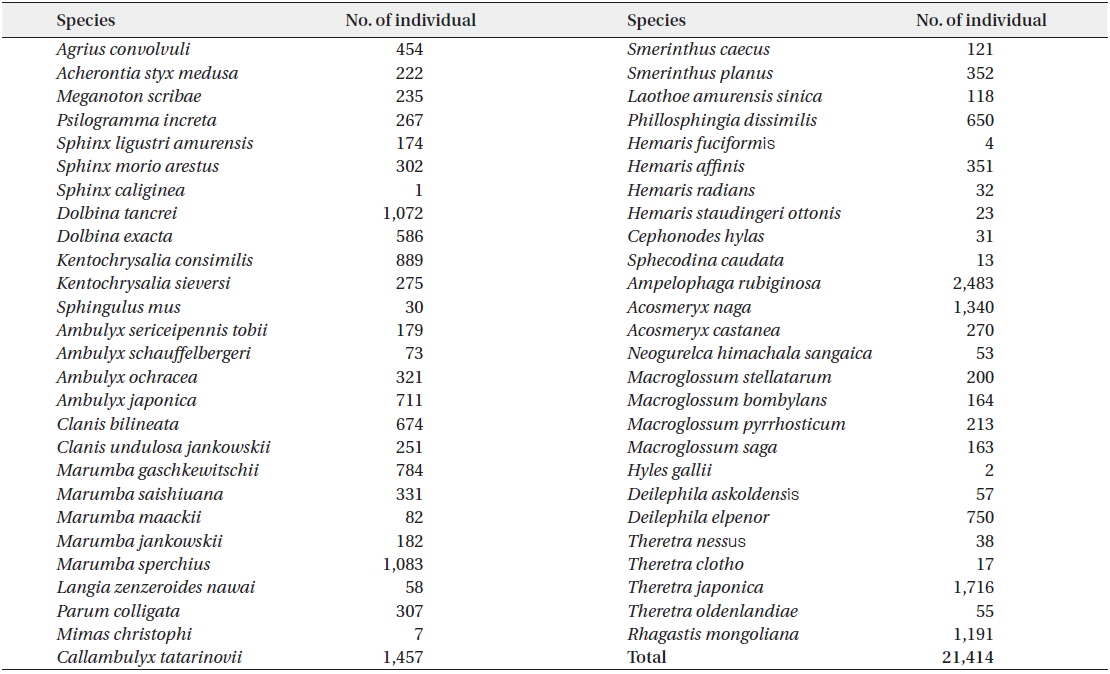
Number of data samples used in the study
>
Species distribution by region
There were 53 Sphingidae moth species housed in Korea. As 48 species and 47 species were found in Gyeongsangnam-do and Gangwon-do, respectively, it was considered that relatively diverse species were distributed in these areas. Comparatively, in Jeollabuk-do, only 36 species were found, and 39 species were found in Chungcheongbuk-do as well as in Jeju Island (Table 3). The number of individual Sphingid moths surveyed in Korea was found to be 21,414. With regard to the number of individuals per species,
[Table 3.] Number of species by province area

Number of species by province area
[Table 4.] Number of individuals of each species by province area
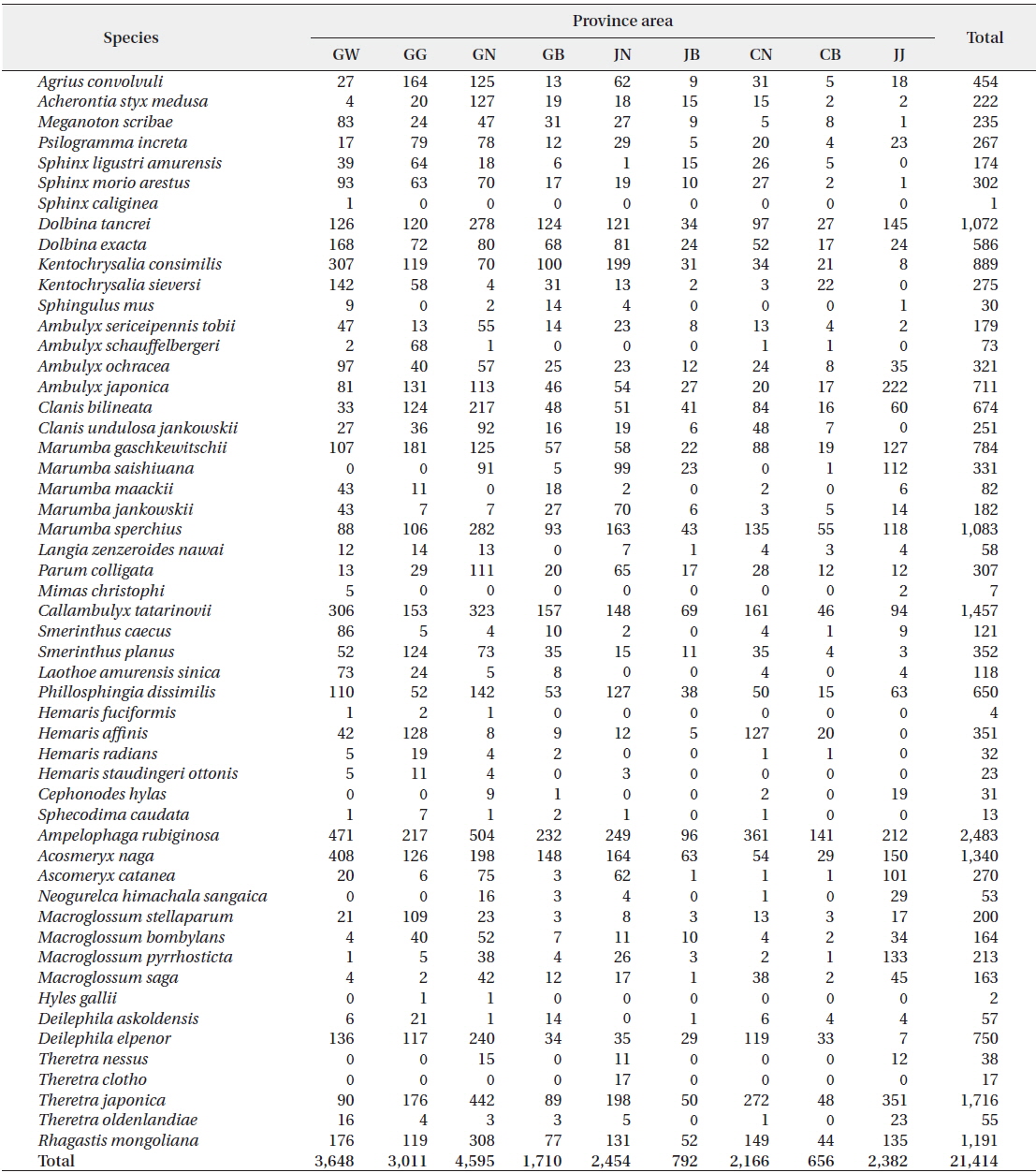
Number of individuals of each species by province area
>
Species distribution by time
If we see the distribution of Sphingid moths identified up to now, the most number such as 9,498 individuals of 52 species were identified after 2000. In 1990s, 6,027 of 49 species, in 1980s 4,332 individuals of 49 species, and, in 1970s, 937 individuals of 45 species were identified. It was confirmed that more species and individuals were identified as time went by (Table 5). Species and individuals of Sphingidae identified in Korea by region and by time do not exactly mean the current distribution or biomass of Sphingidae, as they were not surveyed and identified quantitatively in survey place or time. When checking the progress of appearance by year, 17 species including
[Table 5.] Number of species and individuals over time

Number of species and individuals over time
[Table 6.] Species which increase and decrease over time
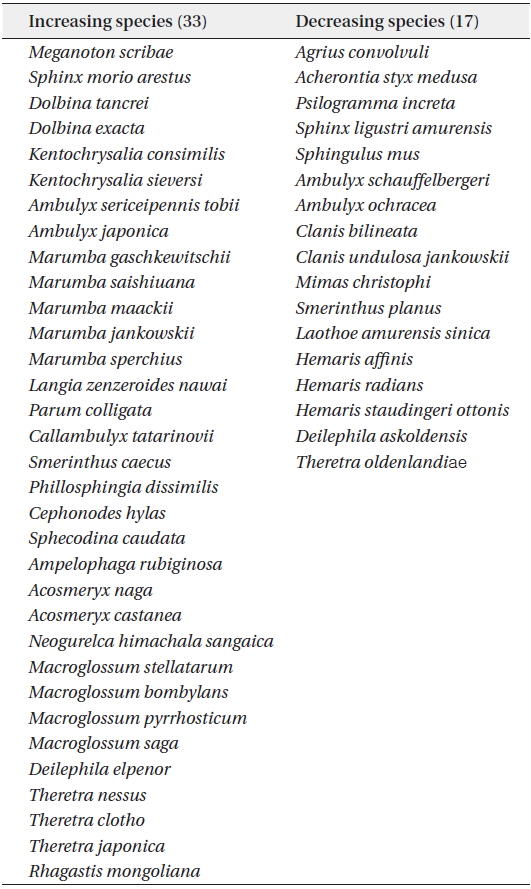
Species which increase and decrease over time
>
Species distribution by season
The appearance of Sphingid moths by month was found to be relatively diverse, as they appear from February to November. By using appearance as the starting point, species which begin to appear in May numbered 26 in total, accounting for approximately half of all species. It was also found that 15 species started to appear in April, while only 3 started to appear in June. With regard to the ending point of their appearance, the number of species lasting until August was highest, at 23, with 17 for September and 5 for October. For the peak of appearance of Sphingid moths, 21 species showed the highest frequency of appearance in July, followed by 10 species in June, 8 in August, and 6 in May. For Sphinginae, most species apart from
[Table 7.] Appearances of samples by month
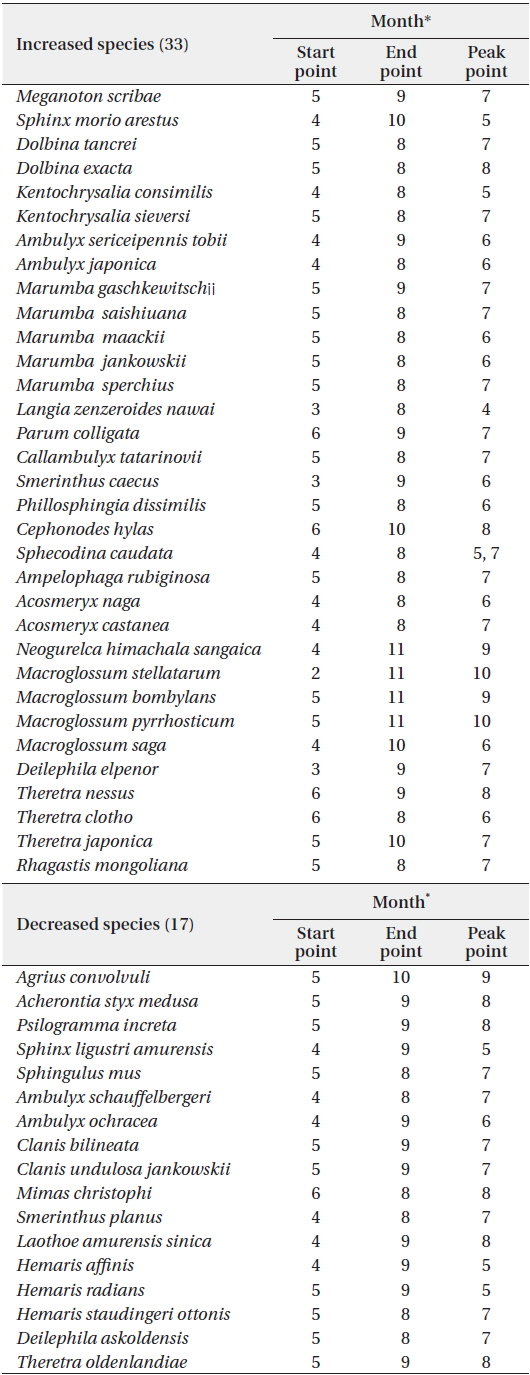
Appearances of samples by month
When analyzing major habitats and distributions by year and month using the information on Sphingidae samples housed in Korea, the southern species
With regard to the monthly appearance of species which mainly inhabit Jeju Island and the southern part of Korea and show recent increases in the numbers of individuals,
With regard to monthly appearances of the species inhabiting the middle or northern parts of the Korean Peninsula or topically all areas of Korea,
On the other hand, species active until relatively late in the year, such as species with very early appearance times, including




